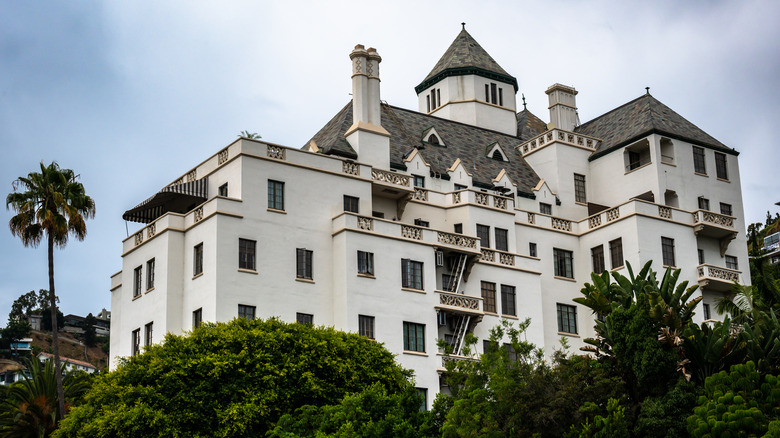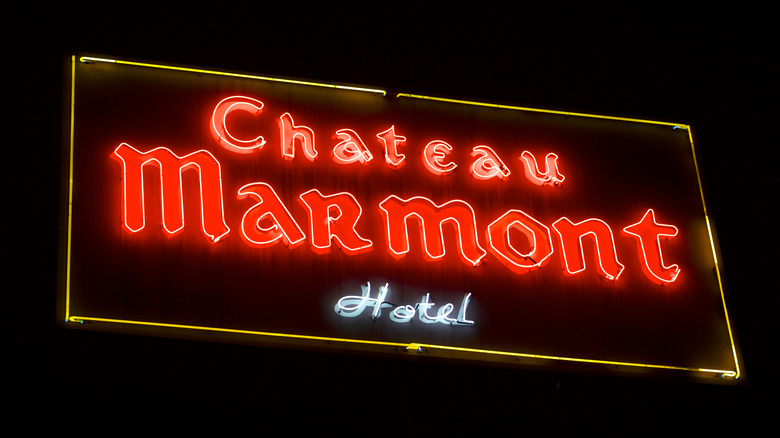Los Angeles' Renovated Celebrity Hotel Is A French Chateau Replica With A Fascinating, Infamous History
Amid the massive billboards and characterless office buildings lining the Sunset Strip, a mysterious, castle-like edifice looms on a hill, towering high over the perpetual stream of traffic below. At night, a red neon sign glows, its letters curved into a commanding, medieval font that reads: Chateau Marmont.
From legendary five-star hideaways that host Hollywood royalty like the Beverly Hills Hotel, to glamorous hotels haunted by silver screen icons like the Hollywood Roosevelt, to establishments created by and for women like Hotel Figueroa, Los Angeles is no stranger to palatial havens full of history. However, few can hold a candle to the legacy of the historic Chateau Marmont. Beneath a dramatically-vaulted, dark wood ceiling and paved with plush, red carpet, stepping inside its luxurious lobby feels like time traveling to a 19th-century French castle. Yet, deep within the elegantly appointed belly of the beast, the phantoms of Hollywood's lurid past perpetually linger.
Dating to 1929, the seven-story, Gothic-style chateau has seen many lives, and kept even more secrets. A hideaway for the rich and famous since the Golden Age, if its elegantly adorned walls could talk, they'd whisper of the hushed celebrity affairs, debaucherous parties, and tragic deaths. Immortalized in film, song, and literature, veiled in myth and mystique, the Chateau Marmont is more than a hotel — it's a living legend.
The history of Chateau Marmont
Originally, Chateau Marmont was conceived as a luxury apartment complex. Designed by renowned architect William Douglas Lee, the grand structure was inspired by Château d'Amboise, an enchanting edifice in France's lush Loire Valley. At the time of its construction, Sunset Boulevard was not the bustling, eyesore-endowed street as we know today, but a dirt road running through an onion field. Chateau Marmont stood out, as it still does, rising like a Gothic goddess over the steadily growing landscape of La La Land.
However, following the dramatic stock market crash of 1929, the rooms remained empty, forcing the original owner — an ambitious attorney named Fred Horwitz — to sell his opulent apartment building on the hill. In the early 1930s, the Chateau's new owner, Albert E. Smith, reimagined the French-inspired fortress and transformed it into a full-service hotel. From there, it quickly became a hideaway for Hollywood's elite, luring legendary guests like Jean Harlow — said to have conducted a love affair there with the king of Hollywood, Clark Gable — and horror icon Anthony Perkins, a closeted actor who allegedly rendezvoused with fellow secretly gay star, Tab Hunter, after meeting by the hotel's glimmering pool.
In essence, it became a place where celebrities could retreat to indulge in their forbidden fantasies — an elevated "no-tell motel" where they concealed their most scandalous secrets. Before the telltale sign illuminated its entrance, the mysterious manor's placement on a curving stretch of Sunset Boulevard shielded it from prying eyes. The lush foliage surrounding it added a veil of anonymity, and the informal hush-hush policy of its staff members forged a reputation of sworn secrecy. Due to its discretion, the chateau crafted a legacy of lore that, to this day, continues to haunt its historic halls.
The secrets of Chateau Marmont
The hotel's registry reads like the credits of a film with an all-star cast. Garnering a rock-star reputation, Room 29 is where The Eagles wrote some of their greatest hits and is allegedly the room in which Led Zeppelin composed "Stairway to Heaven." Room 64 hosted Hollywood hermits Greta Garbo and Howard Hughes, as well as A-listers like Barbra Streisand and Warren Beatty. 1960s starlet Sharon Tate and her husband Roman Polanksi lived in Room 54 before moving to their doomed residence on Cielo Drive. Marilyn Monroe was a frequent guest, particularly while filming "Bus Stop." Director Billy Wilder, who worked with Monroe on cinematic touchstones like "Some Like it Hot," loved the hotel so dearly that he once occupied a small room outside the ladies restroom, insisting he'd "rather sleep in a bathroom than at any other hotel."
Buried amidst the glitz and glamour of Chateau Marmont, some rooms are colored by much darker histories. Bungalow 3 is the site of the tragic overdose that claimed the life of John Belushi, whose spirit is rumored to wander the hallowed halls. Meanwhile, Bungalow 2 was a haven for middle-aged filmmaker, Nicholas Ray, who engaged in a statutory tryst with one of his teenage "Rebel Without a Cause" stars, 16-year-old Natalie Wood.
In more recent years, Lindsay Lohan infamously racked up a whopping $50,000 in hotel charges and was promptly ejected. Nostalgic songstress Lana Del Rey's soft spot for the hotel has inspired song lyrics and poolside concerts, while Miley Cyrus is known to give impromptu performances in the lobby. From balcony-swinging Jim Morrison to dangerously-dozing Bette Davis — who nearly lit the hotel on fire after falling asleep with a lit cigarette — the Chateau Marmont is brimming with secrets, many of which it may never betray.


